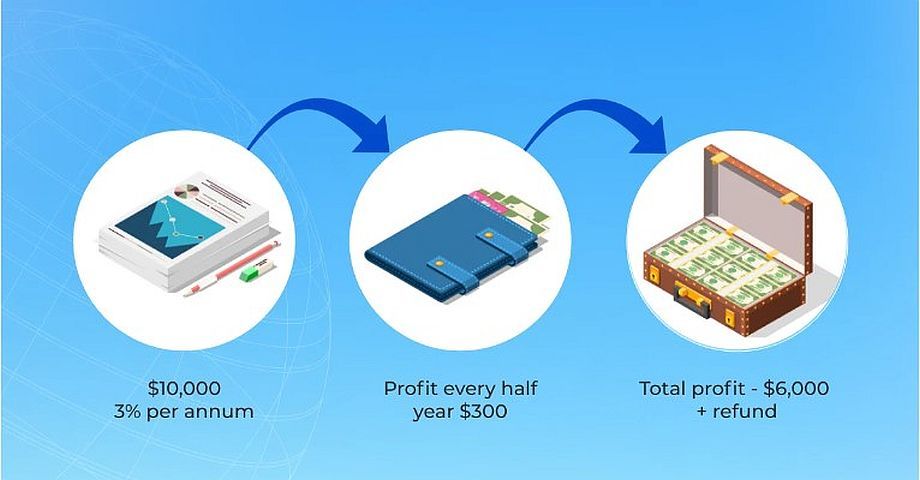What are bonds
To attract investment, companies issue stocks and bonds. Shares are a share of the business that gives you the right to receive a share of the profits. The shareholder’s income depends on the company’s performance. You can read more about stocks here.
Bonds are more like a promissory note that a company gives to an investor. In this article, let’s understand what bonds are, what they are, and how investors make money on them.
Bonds: what they are and how they work
People, companies, and even countries alike need money. Companies attract investment to expand their businesses, countries attract investment to replenish their coffers. If they can’t get money from a bank, they issue bonds.
Bonds are a type of security that a company issues to get money. When an investor buys assets, he lends a company a certain amount of money. The terms when the company has to pay back the money and at what interest rate are spelled out in the document. Therefore, the investor knows exactly the date and the amount of profit he will get if the company doesn’t go bankrupt. If the company goes bankrupt, there is a risk of losing all the money, as bonds are not protected by deposit insurance.
There are two ways to make money on bonds
- Buy and hold the assets until their maturity date, earning interest that is paid twice a year.
For example, you buy a long-term bond from a company with a 10-year payout period for $10,000 with a 3% annual payout. In return for your contribution, the company will pay you 3% of that $10,000 ($300) every six months and in 10 years it will pay you back $10,000. In total, you will get a return of $6,000 + your money back.
2. Earn on the price difference and sell when the price of the asset is more expensive than when you bought it.
For example, if you buy a bond for $5,000, and when the market price goes up, for example because of economic factors or the popularity of the company — sell for $8,000. In total, you will make $3,000 on the price difference.
Types of bonds
There are several classifications of securities: by form of profit payment, by maturity, by issuer (who issues the bonds), by convertibility, by security, and by method of circulation.
A distinction is made between interest-bearing (coupon) and discount bonds according to the form of profit payment.
– Interest-bearing (coupon) bonds. The owners of these securities receive a percentage of their nominal value. Interest can be fixed, that is, a person knows exactly how much money he will receive and when, or floating – payments are tied to market conditions or macroeconomic indicators.
– Discounted. These assets are sold at less than face value and redeemed at the real price. For example, you buy a bond for $100, and when it comes time to pay it off, you get $300 (full face value). A discount is the difference between the offering price and the face value.
A distinction is made between short-term, medium-term, and long-term assets. The former mature in less than a year, the latter in 1-5 years, and the latter in 5+ years.
Depending on the issuer, a distinction is made between government, municipal and corporate securities.
– State securities. Issued by the federal government to cover budget deficits and are considered one of the safest types of investments. A disadvantage is low-interest rates.
– Municipal. Issued by cities, counties, and other local governments to finance a variety of projects. For example, the construction of schools, kindergartens, parks, etc.
– Corporate. Issued by companies when they need to raise money to develop a new direction, project, or introduce innovative technology. Unlike shares, the purchase of a corporate bond does not give the investor the right to manage the company. Corporate securities are divided into high-yield and investment securities. The former offer a high-interest rate, but the risk of default is higher. The latter pay less interest but are more reliable.
Convertible and nonconvertible assets are differentiated by convertibility. Owners of convertible assets can exchange them for other securities of the company, such as stocks. Holders of non-convertible securities have no such option.
A distinction is made between secured, unsecured and subordinated unsecured assets.
– Secured. The most reliable securities that are secured by collateral — the company’s real estate or equipment. If the company goes bankrupt, the owners of these assets will receive the collateral, sell it and be able to recover the invested funds (in part or in full).
– Unsecured. If the company goes bankrupt, the investors who bought these bonds will receive the funds only after the bankruptcy proceedings have gone through, along with the other investors in the order of priority. There is a great risk that the entire amount invested will not be recovered.
– Subordinated unsecured. The most unreliable option, because when a company goes bankrupt, their owners will receive funds last — after all creditors.
A distinction is made between free and restricted assets according to the method of circulation. Free float assets allow the owner to sell them and change ownership of the securities. On restricted bonds, the company may impose rules and time limits on the sale. For example, the owner cannot sell them within a year or any other period.
Advantages and disadvantages of buying bonds
Risks an investor may face
No one can give a 100% guarantee of a successful investment. When buying bonds, an investor may face the following risks.
- Company default
A company may go bankrupt and not return the investor’s investment. To protect yourself against this, you should purchase secured assets (bonds that are backed by the company’s tax) and be reimbursed by the company’s property or equipment. In addition, the issuing company may be guaranteed by a bank or other company. In this case, the guarantor assumes all reimbursements to investors in case of bankruptcy.
- The risk of changing conditions: terms of repayment, size of interest rate, frequency of payments
If the management of the company realizes that it can’t meet its obligations to investors, it can ask the bondholders to revise the terms.
- Liquidity risk
The value of a company’s assets depends on many factors: performance, reputation, and events that occur. If a company has financial problems or is in the middle of a scandal, asset prices may fall or simply no one will want to buy them. To avoid such a problem, you should carefully review the information about the company before investing.
- Interest Rate Risk
If an investor buys a bond with a fixed interest rate below the market rate – the return will be less than that of owners of similar assets. For example, you bought 5-year bonds with a yield of 15% per annum. A year has passed and the yield on similar assets rose from 15% to 20%. So you will earn less than investors who buy assets under the new conditions. To protect yourself against this risk, it’s a good idea to buy floating-rate interest bonds. If the market improves, interest rates will rise. But if the economy and other factors worsen, interest will fall.
Should I invest in bonds?
The answer to this question depends on the investor. If you don’t like risky investments and want to protect yourself, bonds are a great and stable option for passive income. In the case of stock trading, bonds will help diversify your investment portfolio and protect yourself from losses due to market volatility. Investing can’t be risk-free, but we can help you avoid them. At S-IPO, investors are accompanied by a team of professional analysts who assess risks and analyze the market.




